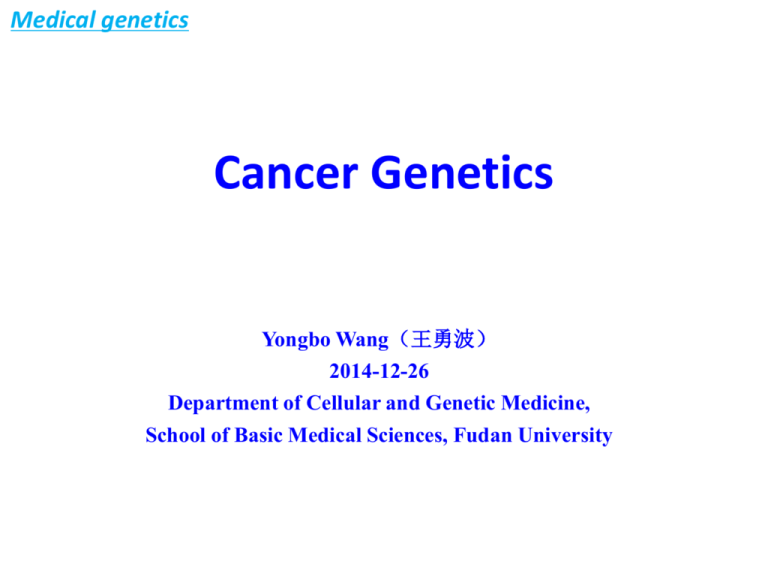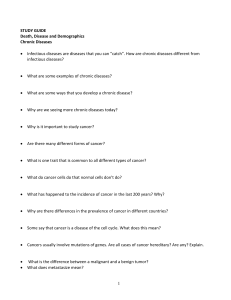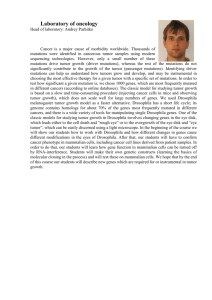cancer
advertisement

Medical genetics Cancer Genetics Yongbo Wang(王勇波) 2014-12-26 Department of Cellular and Genetic Medicine, School of Basic Medical Sciences, Fudan University Outline 1. What Is Cancer? Introduction of the basic concepts 2. What Causes Cancer? Genetic underpinnings of cancer Three types of Cancer Critical Genes Cancer initiation and progression 3. How to Prevent and Diagnose Cancer? Utilization the knowledge we learned from cancer genetics 1. What Is Cancer? Cancer is the most virulent disease and soon becoming the leading cause of death worldwide: as many as ca. 1 in 3 individuals develop cancer and 1 in 4 will die of it. (Percentage of all deaths due to five leading causes of death by year: United States, 1935–2010.) http://www.cdc.gov/nchs/data/databriefs/db88.htm An abnormal cell that grows and proliferates out of control will give rise to tumor or neoplasm. Benign: as long as the tumor cells do not become invasive; Malignant: tumor cells have acquired the ability to invade surrounding tissues. A tumor is considered a cancer only if it is malignant. Metastasis: spread of malignant tumor cells throughout the body (typically through the blood and lymphatic system) There are a large variety types of cancer which are classified according to the tissue and cell type from which they derive: carcinoma (arising from epithelial cells), sarcoma (from connective tissue or muscle cells), leukemia and lymphoma (from hemopoietic cells), cancers derived from cells of nervous system etc. (About 80% of human cancers) Example: development of cancer of the epithelium of the uterine cervix Benign Malignant Adapted from Molecular Biology of the Cell 5th edition Cancer originating from different origin are, in general, very different diseases. Incidence and mortality of different cancers in the United States. Data from American Cancer Society , 2004. Adapted from Molecular Biology of the Cell 5th edition Part 1 summary 1). The basic concepts Benign and malignant tumor Cancer cells reproduce without restraint and colonize other tissues 2). Cancer is a very complex and virulent disease Cancer is becoming the leading cause of death worldwide. There are large variety kinds of cancer which can be classified by their tissue or cell origin. Different types of cancer can be considered as very different disease. 2. What Causes Cancer? • Chemical Exposure – Behavior (Tobacco smoke -> lung cancer) – Environmental (polychlorinated biphenyl, (PCBs)) – Occupational (coal tar, asbestos, aniline dye) – Diet (aflatoxin -> liver cancer) • Radiation (UV -> xeroderma pigmentosum, ionizing) • Infection – Viruses (Epstein–Barr virus (EBV) -> lymphoma, hepatitis B -> liver cancer, papilloma -> cervical cancer etc) • Inherited familial cancer syndromes • Mutations and/or chromosomal abnormalities Most, if not all, of these causes have their genetic underpinning linked with cancer. Aflatoxin B can directly reacting with on DNA and induce mutations - Is a toxin from mold that grows on grain and peanuts when stored in humid tropical conditions; - and a contributory cause of live cancer in the tropics with a characteristic mutations in TP53. Rous sarcoma virus (RSV) - First characterized in 1910 by F. Peyton Rous from a chicken tumor, later named the Rous sarcoma virus; - mid-1970s, Michael Bishop & Harold Varmus (Nobel Prize 1989) demonstrated normal animal cells contain non-cancer causing genes (c-Src) closely related to viral oncogenes (v-Src). Normal Transformed Animal Fibroblast Cancer Arises From Malfunction of Genes: mutations and/or aberrant expression Proto-oncogenes and oncogenes Tumor suppressor genes DNA repair genes Germline vs. Somatic mutations Germline mutations Parent Mutation in egg or sperm Child All cells in affected offspring inherited from parents and present in egg or sperm Cause inherited cancerpredisposing syndromes Account for ~ 5% of all cancers Somatic mutations Somatic mutation (eg, breast, lung etc) Are not heritable Occur in specific tissues Responsible for the majority, possibly all, types of cancers Proto-oncogenes and oncogenes Proto-oncogene: genes which are involved in the promotion of cell division and proliferation, in which gain of function mutation can drive a cell toward cancer; Oncogenes: mutation, overactive or overexpressed forms of proto-oncogenes. Gain of function; dominant at cellular level. “Accelerator” Functions of Cellular Proto-Oncogenes 1. Secreted Growth Factors 2. Growth Factor Receptors 3. Cytoplasmic Signal Transduction Proteins 4. Nuclear Proteins: Transcription Factors 5. Cell Cycle Genes 6. Anti-apoptosis Genes Examples of Oncogenes • RAS - GTPase - activated in many cancers • c-MYC –Transcription factor - overexpressed in colon cancer, amplified in lung, rearranged in lymphoma • RET - Tyrosine kinase - multiple endocrine adenomatosis type 2A (MEN2A) • MET - Tyrosine kinase - hereditary papillary renal cancer • CDK4 – Cell cycle - familial melanoma • BCR/ABL - Tyrosine kinase - chronic myeloid leukemia t(9;22) • BCL2 – Anti-apoptosis- follicular lymphoma t(14;18) Activation mechanisms of proto-oncogenes (proto-oncogene --> oncogene) Activation via chromosomal translocation Diagrammatic representation of 9:22 chromosomal translocation seen in chronic myeloid leukemia (CML), the formation of BCR-ABL oncogene and its detection by FISH. (Encoded activated tyrosine kinase) Adapted from Molecular Biology of the Cell 5th edition and http://www.slh.wisc.edu/clinical/cytogenetics/fish/ Fluorescent in Situ Hybridization (FISH) • Certain chromosomal translocations are easily detected by FISH • Fluorescent in Situ Hybridization – probes on different chromosomes labeled with distinct Fluorophore. Activation via gene amplification chromosomal changes and amplification in MYC gene in cancer cells (eg. neuroblastoma, lung cancer etc) resulting in double minute chromosomes. Activation by point mutation Point mutations in RAS genes resulting in reduced intrinsic GTPase activity have been identified in several tumors, including pancreatic, colorectal, lung and bladder cancer. Point mutations producing constitutively active form of RAS, promoting cell growth. S. Schubbert, K. Shannon, and G. Bollag. Nat Rev Cancer, 2007. 7(4): 295-308. Tumor Suppressor Genes Normally exerts a negative effect on cell division and proliferation. Recessive at cellular level. Loss of function in both alleles result in uncontrolled cell division and tumor formation - ‘Loss of Heterozygosity’ and ‘Two Hit Hypothesis’. “Brakes” Examples of tumor suppressor genes Disorders in which gene is affected Gene (locus) Function Familial Sporadic DCC (18q) cell surface interactions unknown Colorectal cancer WT1 (11p) transcription Wilm’s tumor lung cancer Rb1 (13q) transcription retinoblastoma small-cell lung carcinoma p53 (17p) transcription Li-Fraumeni syndrome breast, colon, & lung cancer BRCA1(17q) BRCA2 (13q) transcriptional regulator/DNA repair breast cancer breast/ovarian tumors Mechanisms Leading to Loss of Heterozygosity Normal allele Mutant allele Loss of normal allele Chromosome loss Deletion Unbalanced Loss and Mitotic translocation reduplication recombination Point mutation Retinoblastoma • Retinoblastoma - tumor of retinal stem cell • Affects 1 in 20, 000 live-born infants • Average age at presentaion – unilateral 26 months – bilateral 8 months • Males and Females equally affected • Occurs in familial (~40%) and sporadic (~60%) forms • Familial more likely to be bilateral, younger • RB1 gene on chr 13 (first tumor suppressor gene discovered) Genetic Features of Heritable Retinoblastoma Knudson Two Hıt hypothesıs Familial RB (%30) Rb Rb Rb LOH Tumor cells Rb Rb Normal cells Rb Inactivation of a tumor suppressor gene requires two mutations, inherited mutation and somatic mutation. LOH: Loss of Heterozygosity Normal cells Genetic Features of Sporadic Retinoblastoma Knudson Two Hıt hypothesıs Normal Cells RB RB RB RB RB Mutation RB LOH Tumor cells Inactivation of a tumor suppressor gene requires two somatic mutations. Heritable vs Nonheritable Retinoblastoma Inherited Sporadic Family history Often positive, but affected child may represent a new mutation No affected relatives Average age at presentation 8 months 24 months Tumor distribution Usually bilateral and multifocal Unilateral Increased risk for other primary tumors Osteosarcoma, other sarcomas, None melanoma, bladder cancer Mutational origin One germline and one somatic Both somatic The RB1 Gene • Encodes Rb protein which is involved in cell cycle regulation; • mutations of Rb have also been identified in various other cancers, including osteosarcomas, small-cell lung carcinomas, bladder, breast, pancreatic and prostate cancers. Long-Term Survival of Children With Heritable Retinoblastoma 35 No Radiotherapy 30 Mortality 25 (%) 20 15 10 Radiotherapy 5 0 1 10 20 30 Years after diagnosis 40 Eng C et al. J Natl Can Instit 85:1121, 1993 TP53 tumor suppressor gene TP53 resides in Chr. 17 and encodes a protein p53 with molecular weight 53 kDa. ‘Guardian of the genome’: Loss of function mutations in TP53 are the most common genetic changes observed in human cancer, with mutations found in > 50% of all tumors. Germline mutations in TP53 cause the inherited cancer predisposing condition known as ‘LiFraumeni syndrome’, a rare autosomal dominant syndrome characterized by neoplasms at multiple sites, including breast cancer, soft tissue sarcomas, brain tumors, osteosarcoma, leukemia, and adrenocortical carcinoma. Modes of action of the p53 tumor suppressor When mutated: Not essential for normal development; (G1 -> S arrest) cells with DNA damage continue cell cycle; escape apoptosis; genetic instability and accumulate mutations; resistance to drugs and irradiation. (regulate BCL2 pathway) Adapted from Molecular Biology of the Cell 5th edition DNA Repair Genes These are genes that ensure each strand of genetic information is accurately copied during cell division of the cell cycle. Mutations in DNA repair genes lead to an increase in the frequency of mutations in other genes, such as proto-oncogenes and tumor suppressor genes. BRCA1/2 in Breast/ovarian cancer • Breast cancer affects 1 in 10 women and represents 31% of cancers in women (~185,000 women diagnosed each year). • ~5% of breast cancers are hereditary, with age of onset earlier than sporadic forms (mutations at 2 alleles). • Inherited breast/ovarian cancer is an autosomal dominant condition and occurs as a result of mutations in DNA repair genes: BRCA1 (Chr17) and/or BRCA2 (Chr13). • BRCA1 is important for homologous recombination, cellular repair of DNA damage, and transcription of mRNA. • Mutations in BRCA1 also are involved in ovarian cancer. • BRCA2 plays a role in timing of mitosis in the cell cycle. BRCA mutation and the risk of breast/ovarian cancer http://www.myriad.com/patients-families/disease-info/breast-cancer/ Human Non-Polyposis Colon Cancer (HNPCC) •2-3% of all colorectal cancer (CRC) cases. • Autosomal dominant, high penetrance. • Typical age of cancer onset is 40-50 years. • High lifetime risk of CRC and other cancers beginning age 20. • Caused by mutations or deletions in mismatch repair (MMR) genes MSH2, MLH1, MSH6, (PMS2) , with 90% of detectable mutations in MSH2 and MLH1 • Tumor formation requires mutation at the second allele. • All four genes have homologs in yeast. • DNA blood tests are available for all four genes. Cancer Risks in HNPCC 100 80 Colorectal 78% 60 % with cancer 40 Endometrial 43% Stomach 19% Biliary tract 18% Urinary tract 10% Ovarian 9% 20 0 0 20 40 60 80 Age (years) Aarnio M et al. Int J Cancer 64:430, 1995 Tumor initiates from a single founding cell Schematic illustration of tumor clonal evolution. Adapted from Molecular Biology of the Cell 5th edition Age dependent colon cancer incidence Tumor progress with accumulation of mutations: one mutation is often not sufficient to cause cancer (c) Lung cancer Part 2 summary 1). Cancer as a genetic disease Both external and intrinsic causes demonstrate genetic changes linked with cancer. 2). Cancer Arises From Malfunction of Genes Definition, cellular functions, mechanisms of action in cancer and representative examples of: Proto-oncogenes and oncogenes Tumor suppressor genes DNA repair genes 3). Tumor initiates from a single founding cell and progress with the accumulation of cancer gene mutations. 3. How to prevent and diagnose cancer? For cancers with known causes: Liver cancer: vaccine to hepatitis B; diet without cancer inducing chemicals Lung cancer: away from smoking tobacco Cervical cancer - ‘Pap’ test Colon cancer: colonoscopy Genetic testing for heritable cancer -BRCA1/2 in breast and ovarian cancer -APC in familial adenomatous polyposis -Sets of cancer predisposing genes Prevention and early stage detection is far more effective than treatment! Human Papilloma Virus & Cervical Cancer • Caused by HPV and clinically detected by ‘Pap’ test and HPV Screening. • Types 16 and 18: Cause 70% of cervical cancer. • HPV Types 6 and 11: cause 90% of genital warts. • GARDASIL Vaccine to HPV. • Risk Factors: smoking, having many children, and human immunodeficiency virus (HIV) infection. Genetic test for breast cancer ‘The Angelina Effect’ In 2013, actress Angelina Jolie announced that she had undergone a preventive double mastectomy because she was a BRCA1 gene mutation carrier, which puts her at very high risk for breast and ovarian cancer. Jolie also had a family history of these cancers. Cancer Death Rates in U.S. MALE FEMALE from American Cancer Society Revolution of DNA sequencing technologies I: Sanger sequencing ABI 3730 700-1000 nt 96/384 well II: Next generation sequencing Illumina HiSeq2000 2007-~ 2*100 nt * 800M = 160G Ion Proton ABI 2010-~ 200 nt * 60 M = ~12G Solid ABI 2007-~ (out of market ) 454 Roche 2005~present 1000 nt*1M=1000M (out of market in 2016) III: Single molecule (third generation) sequencing The PacBio™ RS 2010-~ 2000 nt * 50000 Nanopore GridION 2012-~ > 4000 nt read length Sequencing cost decreases very rapidly Francis Collins Craig Venter Human Genome project 1990-2003 >2 billion $ J. Watson’s genome Jan-May, 2007 1 million $ Personal genome Day-Week 2014 <1000$ Personal genome Hour near future <100$ van Dijk, E.L., et al. Trends in Genetics. 2014,30(9): 418-426. Cancer genomics with evolving DNA sequencing Directly screen sets of cancer disposing genes with affordable cost Construct the catalogue of cancer causing genes for each major cancer type Comprehensively profile the gene expression and epigenetic modification changes in cancer More effectively detect tumor in early stage and accurately classify cancer subtypes Devise targeted therapy Monitor the drug response and prognosis Personalized medicine in cancer prevention and treatment Catalogue of cancer critical genes Direct comparison of tumor and normal condition via large scale sequencing International Cancer Genome Consortium (ICGC) https://icgc.org/ The Cancer Genome Atlas (TCGA) http://cancergenome.nih.gov/ Cancer Genome Project (CGP) http://www.sanger.ac.uk/researc h/projects/cancergenome/ Adapted from Vogelstein et al. 2013. Science Example: Mutation landscape in breast cancer Polyak, K. and O. Metzger Filho. Cancer cell, 2012, 22(4): 562-562. Part 3 summary 1). Effective prevention and early detection have been developed for cancers with known causes. 2). Revolutions in DNA sequencing technologies greatly impute cancer genetic testing and targeted therapy, which will eventually lead to personalized medicine in cancer prevention, diagnosis and treatment in the near future. Take-home message 1. What Is Cancer? Malignant tumor and a complex disease 2. What Causes Cancer? Cancer is a genetic disease caused malfunction of genes Three types of Cancer Critical Genes Cancer initiation and progression by 3. How to Prevent and Diagnose Cancer? Utilization the knowledge we learned from cancer genetics







